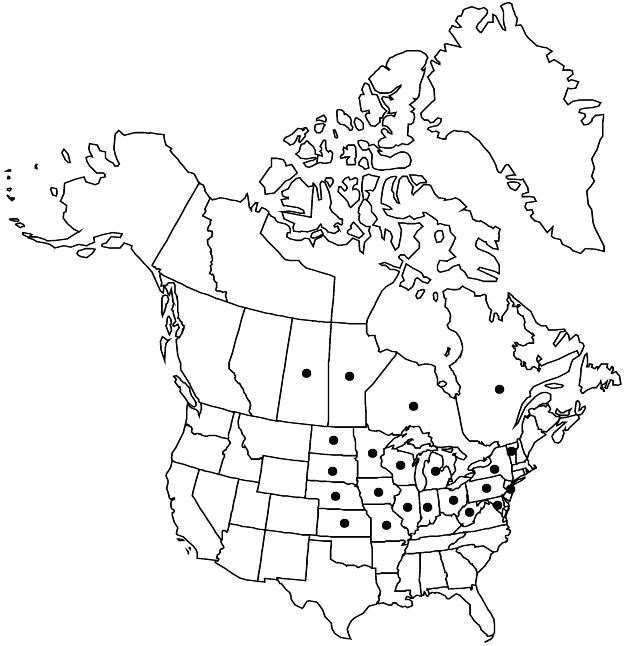Difference between revisions of "Amelanchier humilis"
Rhodora 14: 141, plate 95, figs. 2A–G. 1912.
FNA>Volume Importer |
imported>Volume Importer |
||
| (6 intermediate revisions by 2 users not shown) | |||
| Line 16: | Line 16: | ||
|name=Amelanchier humilis var. campestris | |name=Amelanchier humilis var. campestris | ||
|authority=E. L. Nielsen | |authority=E. L. Nielsen | ||
| − | }}{{Treatment/ID/Synonym | + | |rank=variety |
| + | }} {{Treatment/ID/Synonym | ||
|name=A. humilis var. compacta | |name=A. humilis var. compacta | ||
|authority=E. L. Nielsen | |authority=E. L. Nielsen | ||
| − | }}{{Treatment/ID/Synonym | + | |rank=variety |
| + | }} {{Treatment/ID/Synonym | ||
|name=A. humilis var. exserrata | |name=A. humilis var. exserrata | ||
|authority=E. L. Nielsen | |authority=E. L. Nielsen | ||
| − | }}{{Treatment/ID/Synonym | + | |rank=variety |
| + | }} {{Treatment/ID/Synonym | ||
|name=A. mucronata | |name=A. mucronata | ||
| − | |authority= | + | |authority= |
| + | |rank=species | ||
}} | }} | ||
|hierarchy=Rosaceae;Rosaceae subfam. Amygdaloideae;Rosaceae tribe Gillenieae;Amelanchier;Amelanchier humilis | |hierarchy=Rosaceae;Rosaceae subfam. Amygdaloideae;Rosaceae tribe Gillenieae;Amelanchier;Amelanchier humilis | ||
| Line 40: | Line 44: | ||
|elevation=0–500 m | |elevation=0–500 m | ||
|distribution=Man.;Ont.;Que.;Sask.;Ill.;Ind.;Iowa;Kans.;Md.;Mich.;Minn.;Mo.;Nebr.;N.J.;N.Y.;N.Dak.;Ohio;Pa.;S.Dak.;Vt.;W.Va.;Wis. | |distribution=Man.;Ont.;Que.;Sask.;Ill.;Ind.;Iowa;Kans.;Md.;Mich.;Minn.;Mo.;Nebr.;N.J.;N.Y.;N.Dak.;Ohio;Pa.;S.Dak.;Vt.;W.Va.;Wis. | ||
| − | |discussion=<p>Amelanchier humilis is distinctive in its strongly rhizomatous or suckering habit, erect inflorescences, leaf margins with three to six teeth on distal cm, and preference for basic or neutral soils. Amelanchier humilis was considered to be conspecific with A. spicata by G. N. Jones (1946). Occurrence of A. humilis in Saskatchewan, Kansas, and Nebraska is questionable, as no specimens were seen to confirm its presence there.</p><!-- | + | |discussion=<p><i>Amelanchier humilis</i> is distinctive in its strongly rhizomatous or suckering habit, erect inflorescences, leaf margins with three to six teeth on distal cm, and preference for basic or neutral soils. <i>Amelanchier humilis</i> was considered to be conspecific with <i>A. spicata</i> by G. N. Jones (1946). Occurrence of <i>A. humilis</i> in Saskatchewan, Kansas, and Nebraska is questionable, as no specimens were seen to confirm its presence there.</p><!-- |
| − | --><p>M. L. Fernald (1950) reported hybrids between Amelanchier humilis and A. arborea, A. bartramiana, and A. spicata. The authors have observed putative hybrids with A. amabilis.</p> | + | --><p>M. L. Fernald (1950) reported hybrids between <i>Amelanchier humilis</i> and <i>A. arborea</i>, <i>A. bartramiana</i>, and <i>A. spicata</i>. The authors have observed putative hybrids with <i>A. amabilis</i>.</p> |
|tables= | |tables= | ||
|references= | |references= | ||
| Line 50: | Line 54: | ||
-->{{#Taxon: | -->{{#Taxon: | ||
name=Amelanchier humilis | name=Amelanchier humilis | ||
| − | |||
|authority=Wiegand | |authority=Wiegand | ||
|rank=species | |rank=species | ||
| Line 65: | Line 68: | ||
|publication year=1912 | |publication year=1912 | ||
|special status=Endemic | |special status=Endemic | ||
| − | |source xml=https:// | + | |source xml=https://bitbucket.org/aafc-mbb/fna-data-curation/src/2e0870ddd59836b60bcf96646a41e87ea5a5943a/coarse_grained_fna_xml/V9/V9_1127.xml |
|subfamily=Rosaceae subfam. Amygdaloideae | |subfamily=Rosaceae subfam. Amygdaloideae | ||
|tribe=Rosaceae tribe Gillenieae | |tribe=Rosaceae tribe Gillenieae | ||
Latest revision as of 22:54, 5 November 2020
Shrubs, to 1.5 m (sometimes to 8 m in shaded conditions). Stems 1–50, rhizomatous or suckering and forming scattered colonies. Leaves partly to fully unfolded; petiole (5–)9.3–16.7(–24) mm; blade elliptic or oblong to ovate or obovate, (20–)31–47(–62) × (12–)21–35(–45) cm, base rounded to cordate, each margin with (0 or)1–6(–13) teeth on proximal 1/2 and (0–)3–6(–9) teeth in distalmost cm, largest teeth more than 1 mm, apex broadly subacute to rounded and mucronate, abaxial surface densely hairy by flowering, surfaces sparsely (moderately) hairy (or glabrous) later. Inflorescences (5–)7–11(–14)-flowered, (12–)18–32(–51) mm. Pedicels: (0 or)1(or 2) subtended by a leaf, proximalmost (4–)6–11(–16) mm. Flowers: sepals spreading to recurved after flowering, (1–)1.6–2.7(–3.6) mm; petals to ivory, obovate-oblong, (4.3–)5.9–8.7(–11.3) × (1.4–)2.3–3.9(–5) mm; stamens (14–)18–21(–22); styles (3–)5, (1.8–)2.3–3(–3.6) mm; ovary apex densely hairy. Pomes almost black, 6–8 mm diam. 2n = 2x, 3x, 4x.
Phenology: Flowering Apr–May; fruiting Jul–Aug.
Habitat: Dry, open sites with rocky, gravelly, or sandy soil, calcareous soil
Elevation: 0–500 m
Distribution

Man., Ont., Que., Sask., Ill., Ind., Iowa, Kans., Md., Mich., Minn., Mo., Nebr., N.J., N.Y., N.Dak., Ohio, Pa., S.Dak., Vt., W.Va., Wis.
Discussion
Amelanchier humilis is distinctive in its strongly rhizomatous or suckering habit, erect inflorescences, leaf margins with three to six teeth on distal cm, and preference for basic or neutral soils. Amelanchier humilis was considered to be conspecific with A. spicata by G. N. Jones (1946). Occurrence of A. humilis in Saskatchewan, Kansas, and Nebraska is questionable, as no specimens were seen to confirm its presence there.
M. L. Fernald (1950) reported hybrids between Amelanchier humilis and A. arborea, A. bartramiana, and A. spicata. The authors have observed putative hybrids with A. amabilis.
Selected References
None.